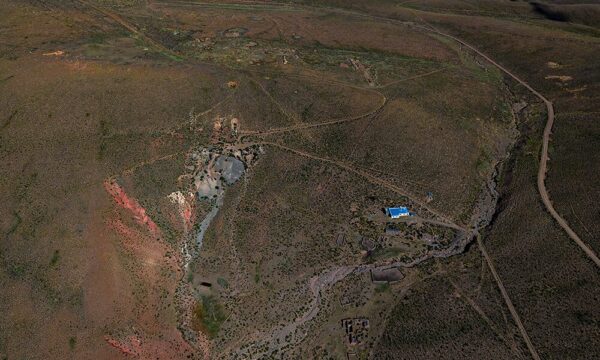On 20 July, Lepidico announced the results of the first seven drill holes from its diamond drilling programme at Alvarrões. In general, the programme confirmed multiple, lepidolite-bearing, near surface pegmatite sills, which were confirmed over at least 300m of strike and 200m down-dip. The lepidolite content of the sills was typically between 15% and 25% and lithium oxide (Li2O) grades as high as 1.4% over 3.35m were recorded (hole ALVD04). The drill results were interpreted by Lepidico management as being indicative of a “large lithium mica mineralised system”, as a result of which, a second drill rig was mobilised to site and mine planning and geotechnical consultants appointed, with a view to expediting a mineral resource estimate after the completion of the drill programme in August. One month after its initial drill results, on 25 August, Lepidico announced the results of a further three holes (ALVD08-11, with one abandoned hole, namely ALVD-09). As at that date, 17 holes had been completed, for a total advance of 1,042m (an average of 61.3m per hole). All told, the holes identified 12 stacked sills (denoted H-S). Importantly, drilling demonstrated continuity of the thicker sills in Block 1, which were interpreted to extend at least 400m along strike (NE-SW) and 350m down dip (towards the north-west). A conflated summary of the drill holes is provided below and the location of the drill holes overleaf.
Exhibit 1: Alvarrões diamond drill lepidolite-bearing pegmatite significant intercepts, summary
Hole identification |
True thickness
(m) |
Average grade (%, Li2O) |
Metal content factor (m.%) |
ALVD01 |
4.98 |
0.71 |
3.5524 |
ALVD02 |
5.96 |
1.13 |
6.7063 |
ALVD03 |
0.94 |
0.82 |
0.7708 |
ALVD04 |
10.54 |
1.20 |
12.6438 |
ALVD05 |
4.56 |
1.13 |
5.1628 |
ALVD06 |
2.40 |
1.12 |
2.6880 |
ALVD07 |
4.45 |
0.76 |
3.3815 |
ALVD08 |
5.10 |
*1.53 |
7.8030 |
Block 1 totals/averages |
4.87 |
1.10 |
42.7086 |
ALVD10 |
4.97 |
1.38 |
6.8404 |
ALVD11 |
6.76 |
1.15 |
7.7435 |
Totals/averages |
5.07 |
1.13 |
57.2925 |
Source: Lepidico, Edison Investment Research. Note: *Includes one sample over limit (>10,000ppm Li) being re-assayed.
Note that, for the purposes of the above table, true widths represent a conflation of all of the separate, individual sample widths. The average grade is weighted by individual sample width.
In all but three holes, the true width of the intersection was reported to be the same as the down-hole interval, indicating that the drill hole intersected the sill at right angles (as desired). All of the holes intersecting at right angles were drilled at a dip of 90°, indicating that the sills are essentially flat-lying.
Exhibit 2: Alvarrões diamond drill hole location
|

|
|
|
Note that Block 1 has been studied by holes ALVD01-08, while Block 3 has been probed by holes ALVD10-11.
Under the terms of its agreement with Grupo Mota (announced on 9 March 2017), Lepidico is undertaking development expenditure of at least €250,000 over an 18-month exclusive period on Alvarrões with the goal of defining a JORC-compliant mineral resource of >1Mt at a grade of 1.5% Li2O. In return, Lepidico will have an exclusive/pre-emptive right for three years in which to effect a commercial relationship with Grupo Mota regarding the supply of ore/concentrate from Alvarrões to Lepidico and/or the right for Lepidico to develop and operate a lithium mica mining and concentration project there. To this end, the drill programme was scheduled to be completed by the end of August, with final assay results anticipated by mid-September ahead of a maiden JORC code-compliant mineral resource estimate at Block 1 around the end of September or the beginning of October.
Edison estimates that holes ALVD01-08 (ie Block 1) cover a surface area of approximately 52,212m2. Assuming continuity of mineralisation between the holes implies a volume of mineralised material of 254,079m3, corresponding to a tonnage of 660.6kt at an average density of 2.6t/m3. At an average grade of 1.10% Li2O, such a tonnage would contain 7,247t of Li2O, or 17,921t of lithium carbonate equivalent (LCE) at a conversion ratio of 2.4728 LCE:Li2O by mass. Note that this estimate is, self-evidently, non-JORC compliant and is intended to provide readers and investors with an order of magnitude interpretation of the drilling performed to date only. In our last major sector report, Gold and other metals: Normalisation augers well for exploration, published in October 2016, Edison estimated an in-situ value for non-spodumene lithium of US$25.72/t LCE, on which basis the delineation of 17,921t LCE JORC-compliant resource would have a value of US$0.46m.
Similarly, assuming continuity of mineralisation across all the holes for which assay results have been provided, Edison estimates that holes ALVD01-11 (ie Blocks 1 and 3 combined) cover a surface area of approximately 171,645m2, which, in turn, implies a volume of mineralised material of 869,552m3, corresponding to a tonnage of 2,260.8kt at an average density of 2.6t/m3. At an average grade of 1.13% Li2O, such a tonnage would contain 25,568t of Li2O, or 63,225t of lithium carbonate equivalent (LCE). At a global average in-situ value of US$25.72/t LCE, such a resource should similarly have a value of US$1.63m. Note that drill hole ALVD18, which is currently in progress, should confirm continuity between Block 1 and Block 3. Hole ALVD19 could determine whether Blocks 1 and 3 are part of a larger mineralised system that, as yet, remains to be drill tested. Either way however, management believes that continuity of mineralisation has now been demonstrated over a sufficient area to establish Alvarrões as a primary feed-source of lithium mica for its proposed L-Max plant with a throughput capacity of 30,000tpa to produce c 3,000t of battery grade LCE, planned to be built in Ontario and currently the subject of a feasibility study.
Note that the mineralised pegmatite system at Alvarrões remains open in all directions, including at depth.






















